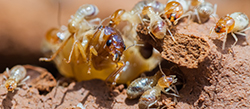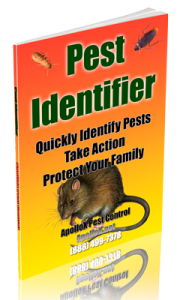 Each year termites cause billions of of dollars in damage to homes in the U.S., making them the most economically important wood destroying insects in the country.
Each year termites cause billions of of dollars in damage to homes in the U.S., making them the most economically important wood destroying insects in the country.
By the time you actually see termites, they have likely already caused major damage to the structure of your home, so it’s important to discover their presence in your home before you actually happen to see a termite. Here’s some help:
Termites In Your Home? Follow the Moisture.
Termites thrive on moisture in the home. Homes stand a higher chance of termite infestation if there is wood paneling or support touching the ground on the exterior of the home, if there are cracks in the foundation or if there are woodpiles or stumps near the home, which are breeding grounds for termites. However, it’s possible to get a termite infestation even if these elements aren’t present.
 Termites In Your Home? Follow the Smell.
Termites In Your Home? Follow the Smell.
Not only can termites do actual structural damage, but they can also cause odor due to their fecal pellets. These fecal pellets also cause discoloration and blisters on your walls, and you may have to replace them completely in order to get rid of the smell and the unsightly stains. Credits: The Trouble with Termites: How Termites Can Ruin Your Home
 Termites In Your Home? Look for Mud Tubes.
Termites In Your Home? Look for Mud Tubes.
You can easily identify Eastern subterranean termites by finding mud tubes. These species can survive only underground, as they need high moisture levels to thrive. They build mud tubes to maintain the requisite humidity levels. They use these tunnels to travel back and forth outside of the colony to gain access to wood and to forage for food. They construct the mud tunnel on anything that comes in direct contact with the ground. These tubes are usually between 1/4 to 1 inch wide, and are generally found in basements, the outside foundation of a home, or protruding from cracks between boards and beams.
Termites In Your Home? Look at the wood.
Other signs of a termite invasion include paint bubbles and small holes in wood. Also, when wood has been attached from the underneath, a hollow sound will emanate from the wood once you tap it with a blunt object or hammer. This indicates the presence of termites within the space they have created inside the structural wood. Credits: DIY Termite Control Options – How To Kill Termites Yourself
When termites are present they eat away at the wood rapidly, leaving it rough and hollow, and oftentimes leaving behind mud and dirt. Credits: 4 Easy tips to expel termite | Home Design, Decorating and Interior …
 Termites In Your Home? Not If You Make Sure They Don’t Get There In the First Place.
Termites In Your Home? Not If You Make Sure They Don’t Get There In the First Place.
We recommend these tips for controlling termites:
- Seal cracks and holes on the outside of the home including entry points for utilities and pipes.
- Keep basements, attics and crawl spaces well ventilated and dry.
- Repair leaking faucets, water pipes and AC units.
- Repair fascia and soffits and rotted roof shingles. Some termites are drawn to deteriorating wood.
- Replace weather stripping and repair loose mortar around basement foundation and windows.
- Store firewood at least 20 feet away from the house and 5 inches off the ground.
- Routinely inspect the foundation of your home for signs of mud tubes (used by termites to reach a food source), cracked or bubbling paint and wood that sounds hollow when tapped.
- Direct water away from your house through properly functioning downspouts, gutters and splash blocks.
- Visit Pestworld.org to find a qualified pest professional for additional advice and treatment if necessary.
Credits: What To Do If You Have Termites – Hulett Pest Control
The most effective way to rid your home of termites is to consult a pest control expert who can help identify the problem and the extent of the damage, rid your home of termites and lay down additional materials to protect against future infestations.















Recent Comments